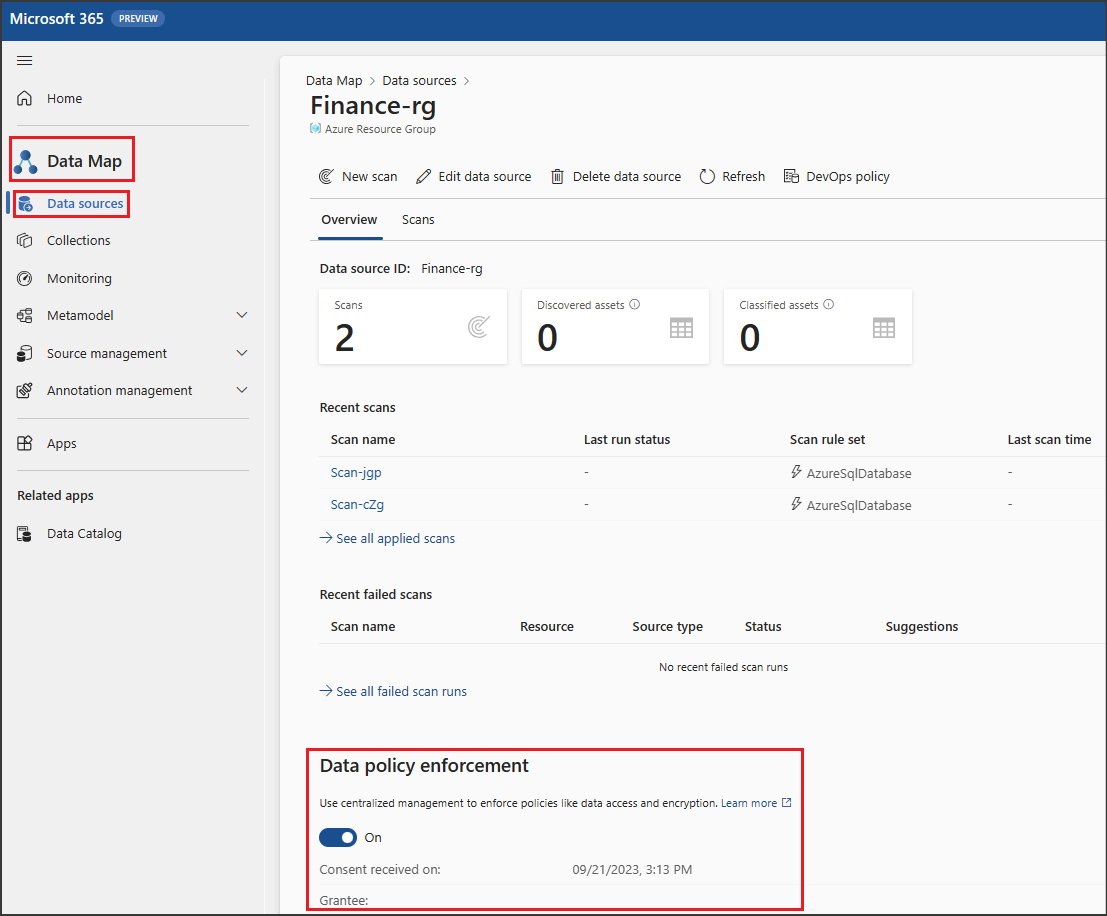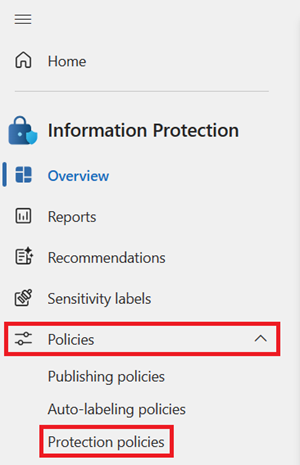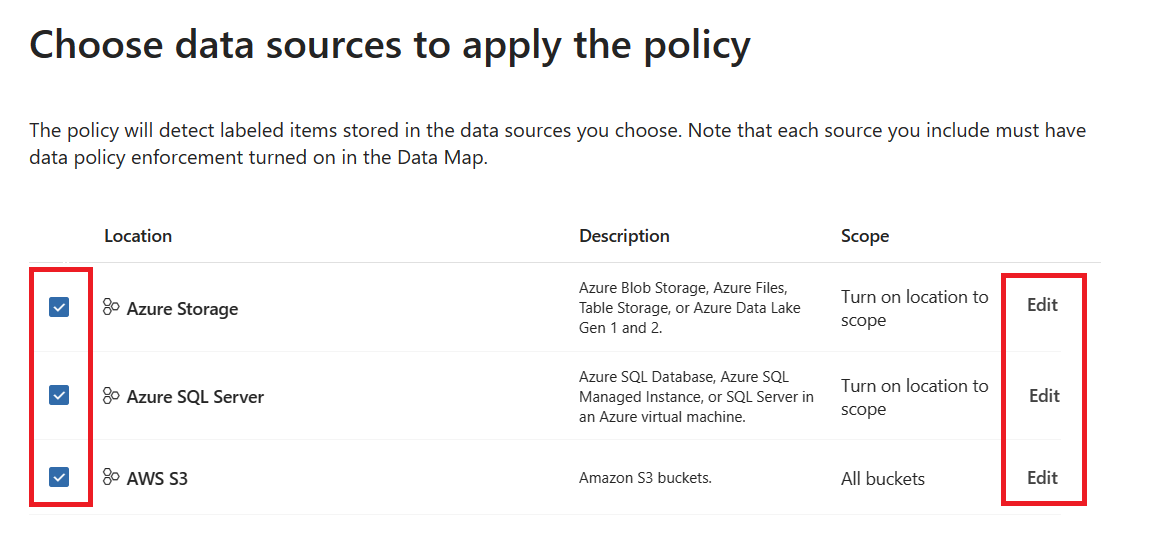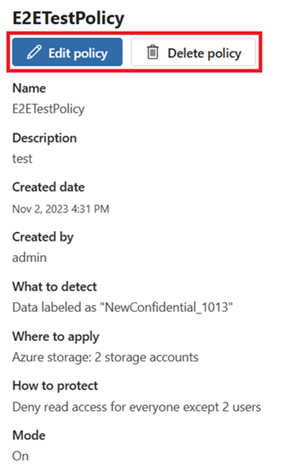Authoring and publishing protection policies for Azure Sources (preview)
Protection access control policies (protection policies) enable organizations to automatically protect sensitive data across data sources. Microsoft Purview already scans data assets and identifies sensitive data elements, and this new feature allows you to automatically restrict access to that data using sensitivity labels from Microsoft Purview Information Protection.
Protection policies ensure that Enterprise Admins must authorize data access for a sensitivity type. After enabling these policies, access control is automatically imposed whenever sensitive information is detected with Microsoft Purview Information Protection.
Actions supported
- Restrict access on labeled data assets so that only users and groups you select can access them.
- Action configured on Sensitivity Labels in the Microsoft Purview Information Protection solution.
Sources supported
- Azure SQL Database
- Azure Blob Storage*
- Azure Data Lake Storage Gen2*
Note
*Azure Storage sources are currently in a gated preview. To enroll, follow this link.
Supported regions
| Region | Azure SQL | Azure Storage |
|---|---|---|
| South Africa North | x | |
| East Asia | x | |
| Southeast Asia | x | |
| Australia Central | x | |
| Australia East | x | x |
| Australia Southeast | x | |
| Brasil South | x | |
| Canada Central | x | x |
| Canada East | x | |
| China East | x | |
| China East 3 | x | |
| China North | x | |
| China North 2 | x | |
| China North 3 | x | |
| North Europe | x | x |
| West Europe | x | x |
| France Central | x | x |
| Germany West Central | x | |
| Central India | x | |
| South India | x | |
| Israel Central | x | |
| Italy North | x | |
| Japan East | x | |
| Japan West | x | |
| Korea Central | x | |
| Norway East | x | |
| Poland Central | x | |
| Qatar Central | x | |
| Sweden Central | x | |
| Switzerland North | x | |
| UAE North | x | |
| UK South | x | |
| UK West | x | |
| Central US | x | |
| East US | x | x |
| East US 2 | x | x |
| North Central US | x | |
| South Central US | x | x |
| West Central US | x | |
| West US | x | |
| West US 2 | x | |
| West US 3 | x |
Prerequisites
Note
It's recommended you use a test tenant to test preview features.
- Microsoft 365 E5 licenses. For the preview, E5 licenses are required in the tenant and assigned to users testing the solution. Microsoft 365 E5 trial licenses can be attained for your tenant by navigating here from your test environment.
- Existing Microsoft Purview accounts upgraded to Microsoft Purview single tenant model and new Portal experience, using the enterprise version of Microsoft Purview.
Users and permissions
There are several types of users you need, and you need to set up the corresponding roles and permissions for these users:
- Microsoft Purview Information Protection Admin - Broad rights to manage Information Protection solution: reviewing / creating / updating / deleting protection policies, sensitivity labels and label/auto-labeling policies, all classifier types. They should also have full access to data explorer, activity explorer, Microsoft Purview Information Protection insights, and reports.
- User needs the roles from within the built-in role group “Information Protection”, along with new roles for data map reader, insights reader, scan reader, source reader. Full permissions would be:
- Information Protection reader
- Data Map Reader
- Insights Reader
- Source Reader
- Scan Reader
- Information Protection admin
- Information Protection analyst
- Information protection investigator
- Data classification list viewer
- Data classification content viewer
- Microsoft Purview evaluation administrator
- Option 1 - Recommended:
- Within the Microsoft Purview role groups panel, search for Information Protection.
- Select the Information Protection role group, select Copy.
- Name it: "Preview - Information Protection", and select Create copy.
- Select Preview - Information Protection and select Edit.
- On the Roles page, + Choose roles and search for “reader”.
- Select these four roles: Data map reader, insights reader, scan reader, source reader.
- Add the Microsoft Purview Information Protection admin test user account to this new copied group and complete the wizard.
- Option 2- uses built-in groups (will provide more permissions than needed)
- Place a new Microsoft Purview Information Protection admin test user account within the built-in groups for Information Protection, Data Estate Insights Readers, Data Source Administrators.
- User needs the roles from within the built-in role group “Information Protection”, along with new roles for data map reader, insights reader, scan reader, source reader. Full permissions would be:
- Data Owner/Admin - This user will enable your source for data policy enforcement in Microsoft Purview.
Prepare your environment and source to apply policies
Enable advanced resource sets in Microsoft Purview:
Have a user who is a data curator or a data reader at the root collection, sign in to the Microsoft Purview portal and open the Settings menu.
Under the Account page, find Advanced Resource Sets and set the toggle to On.

Create or extend sensitivity labels from Microsoft Purview Information Protection to data map assets.
Note
Be sure to also publish your labels after creating them.
Register sources - register any of these sources you like:
Note
To continue, you need to be a data source administrator in the collection where your Azure storage source is registered.
Enable data policy enforcement
Go to the new Microsoft Purview portal.
Select the Data Map tab in the left menu.
Select the Data sources tab in the left menu.
Select the source where you want to enable data policy enforcement.
Set the Data policy enforcement toggle to On, as shown in the image below.

Scan sources - register any of the sources you've registered.
Note
Wait at least 24 hours after scanning.
Create protection policy
Now that you've checked the prerequisites and prepared your Microsoft Purview instance and source for protection policies, and waiting at least 24 hours after your most recent scan, follow these steps to create your protection policies:
Depending on the portal you're using, navigate to one of the following locations:
Sign in to the Microsoft Purview portal > Information Protection card > Policies
If the Information Protection solution card isn't displayed, select View all solutions and then select Information Protection from the Data Security section.
Sign in to the Microsoft Purview compliance portal > Solutions > Information protection > Policies
Select Protection policies.

Select New protection policy.

Provide a name and description and select Next.
Select + Add sensitivity label to add sensitivity label(s) to detect for the policy, and select all the labels you want the policy to apply to.
Select Add then select Next.
Select the sources you want to apply the policy to, and select the Edit button to manage the scope for each you select.

Depending on your source, select the + Include button at the top to add up to 10 resources your scope list. The policy will be applied to all the resources you select.
Note
Currently a maximum of 10 resources is supported, and they must be selected under Edit for them to be enabled.
Select Add and then select Done when your list of sources is complete.
Select the users who will NOT be denied access based on the label. Everyone in your org will be denied read access to labeled items except for the users and groups you add here.
Select Next.
Choose whether turn on the policy right away or not, and select Next.
Select Submit.
Select Done.
You should now see your new policy in the list of protection policies. Select it to confirm that all the details are correct.
Manage protection policy
To edit or delete an existing protection policy, follow these steps.
Open the Microsoft Purview portal.
Open the Information Protection solution.
Select the Policies drop down, and select Protection policies.

Select the policy you want to manage.
To change any of the details, select the Edit policy button.
To delete the policy, select the Delete policy button.

Feedback
Coming soon: Throughout 2024 we will be phasing out GitHub Issues as the feedback mechanism for content and replacing it with a new feedback system. For more information see: https://aka.ms/ContentUserFeedback.
Submit and view feedback for